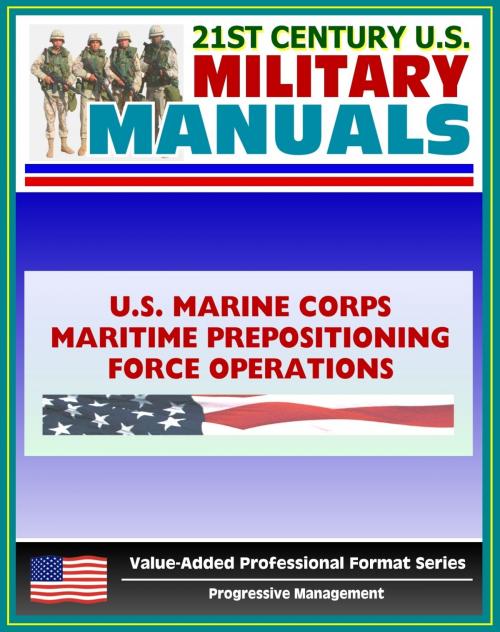21st Century U.S. Military Manuals: Maritime Prepositioning Force Operations Marine Corps Field Manual (Value-Added Professional Format Series)
Nonfiction, Social & Cultural Studies, Political Science, Government, History, Military| Author: | Progressive Management | ISBN: | 9781465876461 |
| Publisher: | Progressive Management | Publication: | September 28, 2011 |
| Imprint: | Smashwords Edition | Language: | English |
| Author: | Progressive Management |
| ISBN: | 9781465876461 |
| Publisher: | Progressive Management |
| Publication: | September 28, 2011 |
| Imprint: | Smashwords Edition |
| Language: | English |
Part of our value-added professional format series, the Maritime Prepositioning Force Operations Marine Corps Field Manual provides Navy and Marine Corps operational forces with information essential to planning and execution of MPF operations. Additionally, it addresses command responsibilities and organizational structure during each phase of an MPF operation to include its components and terminology. This publication represents a focal point from which further MPF doctrine, tactics, techniques, and procedures may be developed.
An MPF operation is the rapid deployment and assembly of a MAGTF in a secure area using a combination of strategic airlift and forward-deployed maritime prepositioning ships.
MPF operations are a strategic deployment option that is global in nature, naval in character, and suitable for employment in a variety of circumstances. As such, MPF operations provide an essential element in the conduct of national military strategy. MPF operations are predicated on the concept of flying the personnel of a MAGTF and NSE into a host nation arrival and assembly area to join with equipment and supplies prepositioned aboard forward-based MPS(s).
Maritime prepositioning provides Unified Combatant Commanders (CINCs) with deployment flexibility and increased national capability to respond rapidly to crisis or contingency with a credible force. The purpose of an MPF operation is to rapidly establish a MAGTF ashore that is prepared to conduct subsequent combat operations across the operational continuum. Configuration of material on MPS(s) affords CINCs an array of employment options. An MPF operation can consist of one ship and appropriate sized FIE, or at the other end of the scale all three maritime prepositioning ship squadron(s) and a MEF-sized MAGTF. An MPF is one component of the Marine Corps' rapid response capability. This triad of forces includes MPF, Air Contingency Force (ACF), and Amphibious Ready Forces. MPF operations are economy of force measures that allow deployment of an appropriate size force if a crisis arises, and if an early decision and secure arrival environment exists, offers a complement to amphibious assault operations. Other advantages of MPF operations include a means to deploy forces without impact on previously deployed forces, and a method to rapidly augment a forward-deployed MAGTF, ongoing amphibious deployment or operation, or other joint/combined force operation.
As a bonus, this reproduction includes FM-1, The Army Field Manual, a capstone manual containing the vision for the Army - sold separately for $5.99. FM 1 establishes the fundamental principles for employing Landpower. The most important of these are the Army's operational concept and the fundamentals that support it. They form the foundation for all Army doctrine. All Soldiers should understand and internalize them. FM 1 describes the American profession of arms, the Army's place in it, and what it means to be a professional Soldier.
This is a privately authored news service and educational publication of Progressive Management.
Part of our value-added professional format series, the Maritime Prepositioning Force Operations Marine Corps Field Manual provides Navy and Marine Corps operational forces with information essential to planning and execution of MPF operations. Additionally, it addresses command responsibilities and organizational structure during each phase of an MPF operation to include its components and terminology. This publication represents a focal point from which further MPF doctrine, tactics, techniques, and procedures may be developed.
An MPF operation is the rapid deployment and assembly of a MAGTF in a secure area using a combination of strategic airlift and forward-deployed maritime prepositioning ships.
MPF operations are a strategic deployment option that is global in nature, naval in character, and suitable for employment in a variety of circumstances. As such, MPF operations provide an essential element in the conduct of national military strategy. MPF operations are predicated on the concept of flying the personnel of a MAGTF and NSE into a host nation arrival and assembly area to join with equipment and supplies prepositioned aboard forward-based MPS(s).
Maritime prepositioning provides Unified Combatant Commanders (CINCs) with deployment flexibility and increased national capability to respond rapidly to crisis or contingency with a credible force. The purpose of an MPF operation is to rapidly establish a MAGTF ashore that is prepared to conduct subsequent combat operations across the operational continuum. Configuration of material on MPS(s) affords CINCs an array of employment options. An MPF operation can consist of one ship and appropriate sized FIE, or at the other end of the scale all three maritime prepositioning ship squadron(s) and a MEF-sized MAGTF. An MPF is one component of the Marine Corps' rapid response capability. This triad of forces includes MPF, Air Contingency Force (ACF), and Amphibious Ready Forces. MPF operations are economy of force measures that allow deployment of an appropriate size force if a crisis arises, and if an early decision and secure arrival environment exists, offers a complement to amphibious assault operations. Other advantages of MPF operations include a means to deploy forces without impact on previously deployed forces, and a method to rapidly augment a forward-deployed MAGTF, ongoing amphibious deployment or operation, or other joint/combined force operation.
As a bonus, this reproduction includes FM-1, The Army Field Manual, a capstone manual containing the vision for the Army - sold separately for $5.99. FM 1 establishes the fundamental principles for employing Landpower. The most important of these are the Army's operational concept and the fundamentals that support it. They form the foundation for all Army doctrine. All Soldiers should understand and internalize them. FM 1 describes the American profession of arms, the Army's place in it, and what it means to be a professional Soldier.
This is a privately authored news service and educational publication of Progressive Management.















